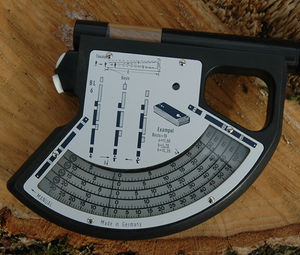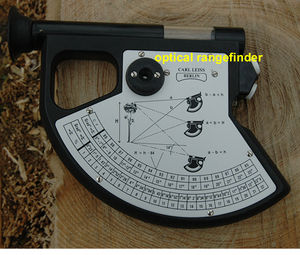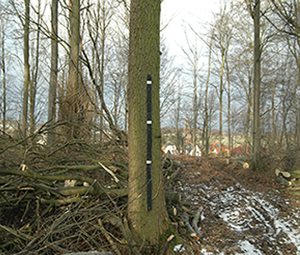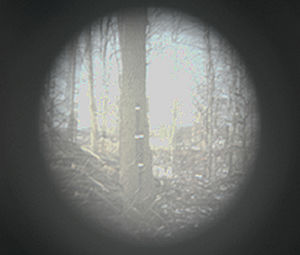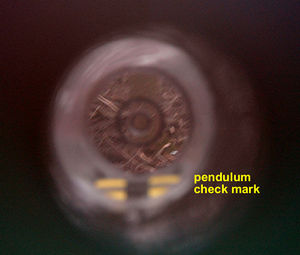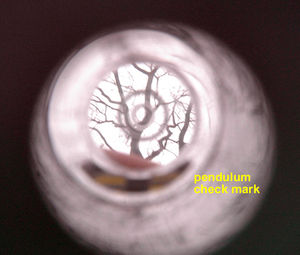Blume-Leiss
Contents |
General description
The Blume Leiss is developed to measure slope and tree height by the trigonometric principle. The device measures the elevation angle between the operator and measured points. Tree heights can directly be read from the device depending on fixed distances of 15m, 20m, 30m and 40m. For mountainous areas slope correction factors can directly be read from the device depending on the slope. Figure 1 shows the front side of the device including:
- example for the viewing while measuring distance with the vertical base measure,
- the scales of height measurement for the fixed distances to the tree (15, 20, 30 and 40m) and
- scale for slope measurement in °.
In this example the type of the device (BL6) has two buttons two separately lockable needles (figure 1), so that the height between the operator and the stem foot / tree crown can directly be read. The difference between the measurements will be tree height ($h_t$): \begin{equation} h_t=h_c-h_b \end{equation}
If the slope is larger than 5 degrees, the tree heights need to be corrected by the formula $CF=e*\tan\alpha_i$. This correction factor (CF) has to be multiplied with the tree height.
The optical rangefinder (figure 2) allows the user to measure the distance to the tree by mirroring a picture of the levelling board. Figure 2 shows the backside of the device where information is given about:
- Height caluation
- b-a=h (slope > 5° - viewing downwards)
- a+b=H (slope < 5° - viewing horizontal)
- a-b=h (slope > 5° - viewing upwards)
- Correction factors
- correction factor depending on slope in °
- slope in ° depending on slope in %
Handling
Distance measurement
- Determine an optimal distance to the tree by checking the visibility of the tree bottom and tree top within the forest stand,
- Place the leveling board at the tree,
- Find the correct fixed distance using the optical range finder by focusing the distance leveling board (figure 3b) and move closer or farther to the tree, until the top of the mirrored board is coincident with the corresponding mark on the leveling board - in this example, the mid mark of the leveling corresponds to a distance of 15m (alternatively a tape measure can be used to find the correct fixed distance)
Height measurement
- Focus the bottom of the tree (figure 4a) and lock the pendulum,
- Focus the top of the tree (figure 4b) and lock the second pendulum,
- The front side of the device (figure 1) shows two height values - the height can directly be derived by the formulas described above, depending on the slope
- Correct the derived height if necessary
Slope measurement
- Sight at the zero mark of the levelling board and lock the needle
- The slope in ° can directly be read from the scale (figure 1)
 Note:
Note:
- When measuring with Blume Leiss, you need to observe the pendulum check mark to be sure, that the pendulum has stopped oscillating before locking the button. All scales are visible at once - be careful of taking the necessary scale.
| Advantages | Disadvantages |
|---|---|
| slope correction implemented | dependance on fixed scales |
| optical distance measurement | fixed distances to the tree (could be difficult in closed forest stands) |
| independence of power sources (no batteries needed) | in dark forest stand optical measurement is difficult |
| no digital storage of measurement results available. |
Applications
